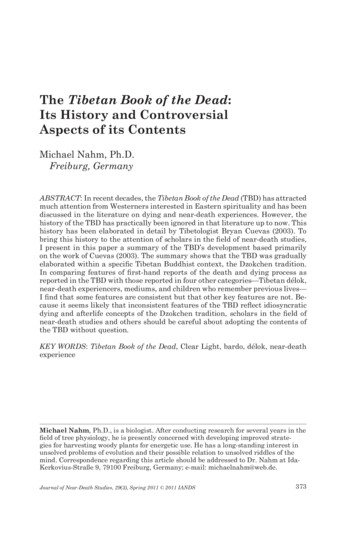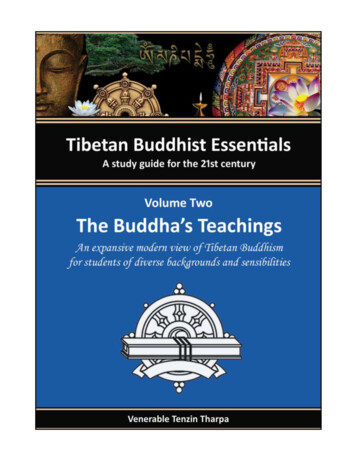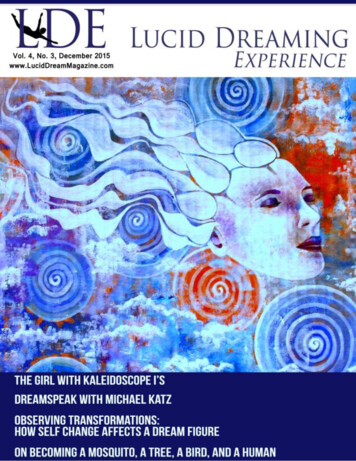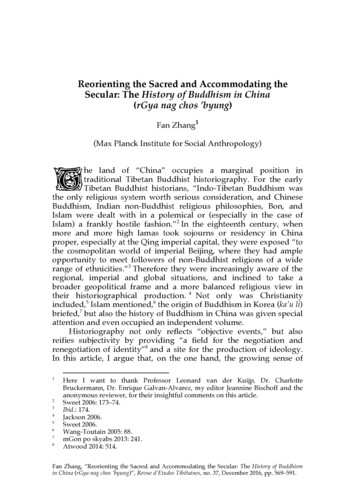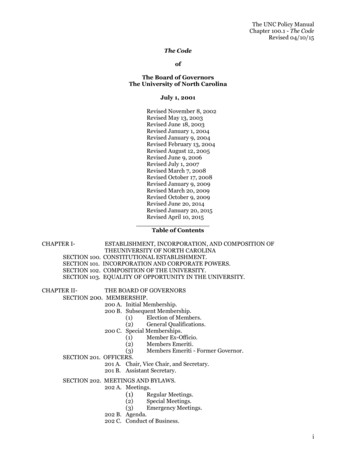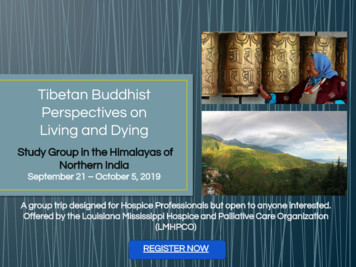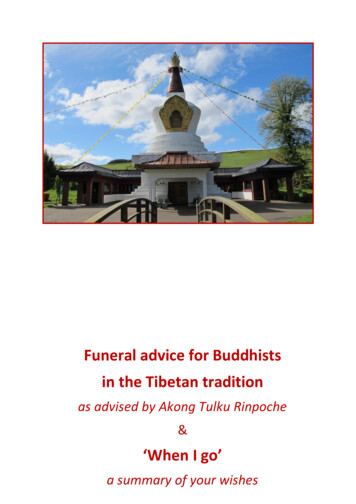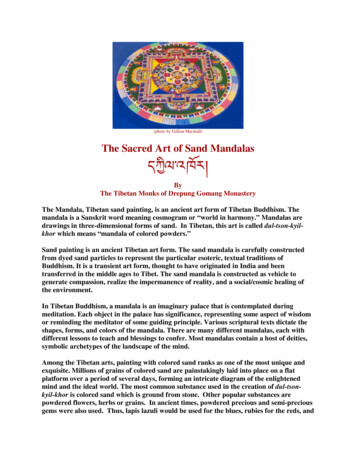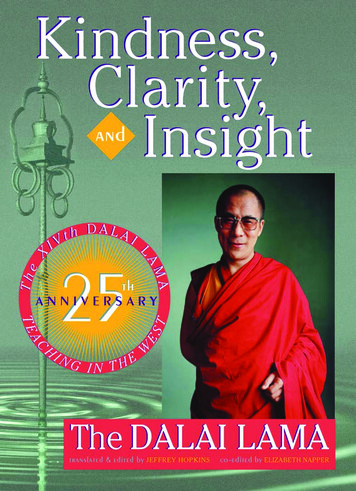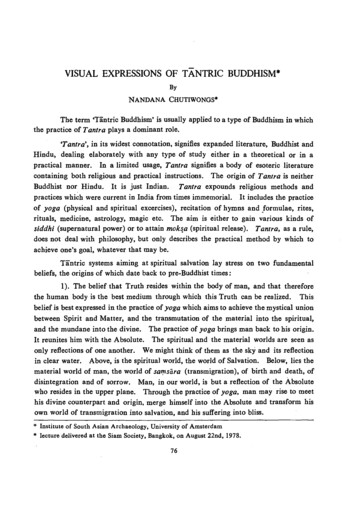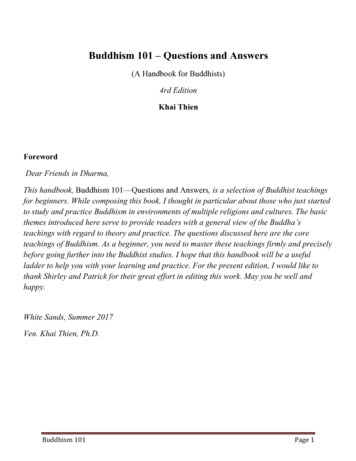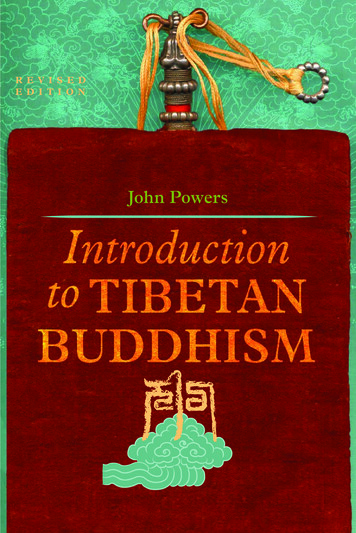
Transcription
R E V I S E DE D I T I O NJohn Powers
Introduction to Tibetan Buddhism
Introduction toTibetan Buddhismrevised editionby John PowersSnow Lion Publicationsithaca, new york boulder, colorado
Snow Lion PublicationsP.O. Box 6483 Ithaca, NY 14851 USA(607) 273-8519 www.snowlionpub.com 1995, 2007 by John PowersAll rights reserved. First edition 1995Second edition 2007No portion of this book may be reproduced by any means withoutprior written permission from the publisher.Printed in Canada on acid-free recycled paper.Designed and typeset by Gopa & Ted2, Inc.Library of Congress Cataloging-in-Publication DataPowers, John, 1957Introduction to Tibetan Buddhism / by John Powers. — Rev. ed.p. cm.Includes bibliographical references and indexes.ISBN-13: 978-1-55939-282-2 (alk. paper)ISBN-10: 1-55939-282-7 (alk. paper)1. Buddhism—China—Tibet. 2. Tibet (China)—Religion. I. Title.BQ7604.P69 2007294.3’923—dc222007019309
Table of ContentsPreface11Technical Note17Introduction21Part One:The Indian Background1. Buddhism in India31The Buddha31The Buddha’s Life and Lives34Epilogue562. Some Important Buddhist Doctrines63Cyclic Existence63Appearance and Reality713. Meditation81The Role of Meditation in Indian and Tibetan Buddhism81Stabilizing and Analytical Meditation85The Five Buddhist Paths914. Mahāyāna101Origins101Mah›y›na Doctrines105The Bodhisattva Path113
6/introduction to tibetan buddhismPart Two:Tibetan History and Culture5. Tibetan Religious History137Tibet: Geography and Environment137The Early History of Tibet139The Period of the Religious Kings144The Second Dissemination of Buddhism155Mongol Influence and Sakya Supremacy159The Gélukpa Ascent to Power163The Seventeenth and Eighteenth Centuries1696. The Twentieth Century181Foreign Conflicts181The Fourteenth Dalai Lama187The Interregnum Period195The Fourteenth Dalai Lama Assumes Power197The Chinese Occupation of Tibet2057. Festivals and Holy Days219Mönlam219The Butter-Sculpture Festival of Kumbum222Sacred Dance226Other Religious Festivals228Common Elements in Tibetan Religious Ceremonies2298. Geography and Architecture233The Religious Environment233Construction of Religious Structures236StÒpas242
contents/7Part Three:Tibetan Buddhist Doctrines and Practices9. Tantra249The Place of the Tantras in Buddhist Literature249Tantra as a Branch of Mah›y›na257Tantric Symbols262Entering Tantric Practice267The Four Classes of Tantra279The Preliminary Practices294The Fourteen Root Downfalls31510. Death and Dying in Tibetan Buddhism325Introduction325Death Meditation: Exoteric and Esoteric Traditions330The Bardo Process341Tibetan Rituals of Death and Dying348Part Four:The Schools of Tibetan Buddhism11. The Four OrdersThe Nonsectarian Movement12. Nyingma355359367History and Doctrines367The Nine Vehicles375Terma: Hidden Treasures378Distinctive Practices: Dzogchen38313. Kagyu399History and Doctrines399Meditation Practices405
8/introduction to tibetan buddhism14. Sakya433Origins of the Sakya Tradition433The Development and Dissemination ofSakya Doctrines and Practices437Sakya Becomes a Political Force442The Sakya Monastic Order445Distinctive Practices: “Path and Result”44715. Géluk467History of the Lineage467The Gélukpa Monastic System477Distinctive Practices: The Stages of the Path48116. Bön: A Heterodox System497Introduction497Bön Teachings and Practices500Chronology of Indian and Tibetan Buddhism515Lexicon of Buddhist Terms521English-Tibetan-Sanskrit Glossary529Select Bibliography561IndexesTechnical Terms577Proper Names584Titles of Works Mentioned589Locations590
To Terry and Leo
Prefacen the decade since the publication of the first editionof this book, a veritable flood of literature has appeared inWestern languages on topics relating to Tibetan religion,history, and culture. At the same time, the availability ofTibetan texts that were either difficult to access or thathad been presumed lost has increased. A number of groundbreaking studies by academics have appeared, and there is now a substantial library oftreatises, videos, and CDs, as well as Internet-based resources by Tibetanmasters describing aspects of their philosophical and meditative traditions, folk tales, traditional stories, biographies and autobiographies, andoral and written discourses on such topics as astrology, divination, andVajray›na.The first edition was the result of years of study in university coursesand libraries with primary texts, secondary works, oral instructions bylamas from the four major orders of Tibetan Buddhism (Nyingma, Kagyu,Sakya, and Géluk), as well as fieldwork in the Himalayan region. The goalof the first edition—and of the present one—was to meet the growingneed for an introduction to Tibetan Buddhism written specifically for people with little or no previous exposure to the tradition.This book is intended for an audience of undergraduates, Buddhistpractitioners looking for an overview of the tradition, and readers with ageneral interest in the subject. It attempts to provide information regarding the history and practices of Tibetan Buddhism in a clear manner, without presuming previous knowledge of the subject, and also withoutassuming the supremacy (or inferiority) of any school or lineage. Its outline is not derived from any traditional organizing structure, and growsI
12/introduction to tibetan buddhismout of my own study of this tradition and my attempts to place its components in context and to make sense of the often conflicting claims andcounterclaims of its exponents.The tragedy of Tibet’s invasion and annexation by the People’s Republic of China in the 1950s has had a devastating effect on the people of Tibetand their rich traditional culture, but the rest of the world has benefitedfrom the resulting diaspora, which has brought Tibetan lamas out of theirmonasteries and retreat huts and into universities and newly-establishedBuddhist centers. Now students can have access to them in ways thatwould have been impossible in traditional Tibet.As a result of their exposure to teachings and teachers from this tradition, thousands of Westerners have become Tibetan Buddhists, and thereis widespread interest even among nonconverts in the public lectures ofsuch luminaries as the Dalai Lama, Sogyel Rinpoché, Pema Norbu Rinpoché, and Sakya Tridzin. Modern technology allows their words to beprinted and disseminated all over the world, in print and electronic forms.Most major cities in North America, Europe, and Australia have at leastone Buddhist center, and many have several representing various denominations. College courses on Buddhism in general and Tibetan Buddhismin particular are a common feature of contemporary curricula.The present incarnation of this book incorporates a number of important new perspectives and theories. In addition, my own expandingknowledge of the subject has rendered some of my earlier conclusionsquestionable or outdated, but the possibility of writing a second editionprovides a mechanism to revise and update my earlier work, one of theluxuries of modern word processing and publishing technology.As with the first edition, the scope of this book is broad, encompassing history, philosophy, ritual, architecture, art, and a range of other subjects, but it still only scratches the surface of this ancient and rich culture.The first part of the book explores the Indian background in which Buddhism arose. It focuses on the figure of the Buddha, some important doctrines attributed to him, the practice and theory of Buddhist meditation,the main distinctions between the Mah›y›na and Hınay›na schools, andthe relation of Vajray›na to other Mah›y›na systems. Part two is concerned with the history and culture of Tibet, and examines its early religious history, the present-day situation of Tibetan Buddhism, and someimportant aspects of the daily religious lives of Tibetan Buddhists. Partthree looks at Vajray›na and at the most influential teaching lineages of
preface/13Tibetan Buddhism, focusing on their histories, important figures, anddistinctive practices.Since beginning serious study of Tibetan Buddhism more than twodecades ago, I have had the good fortune to receive oral instructions fromsome of the most prominent Western scholars of Buddhism as well as eminent and articulate exponents of each of the four orders of Tibetan Buddhism. Grant-giving agencies including the Australian Research Council,the American Philosophical Association, and the American Institute forIndian Studies have generously funded several years of fieldwork study insouth India, the Himalayan region (including Ladakh, Zanskar, Sikkim,and Himachal Pradesh), Nepal, and various sites in northern India. I havereceived oral teachings, both in groups and in private, from scores of lamas,and have been allowed to witness and participate in a number of esotericrituals. These experiences have provided the raw material for this book inboth of its incarnations.The scope of the project lies beyond the expertise of any researcher,and I would like to acknowledge my thanks to the many people who aidedin the process of writing, editing, and correcting the various stages of thetwo editions. Sidney Piburn of Snow Lion Publications deserves creditfor initiating the project and for his help throughout, as well as gentlypressing me to get to work on the second edition. Joe Wilson’s commentsand corrections of the first section made me rethink some of my initialassumptions. Thanks are also due to William Magee for his careful reading of the manuscript and for his comments. Since beginning a teachingcareer, various versions of this work have been studied and critiqued byhundreds of students in the United States and Australia, and many ofthem have made invaluable comments and clarifications. In addition,they have helped me in adapting what I have seen and read to an audience of intelligent people with little or no background in the subject matter, and they have been perhaps my greatest resource in this process.Ronald Davidson’s critique of the Sakya chapter significantly contributedto significant changes in the final version of the first edition, and I havegreatly benefited from several of his conference presentations. I wouldalso like to thank Paul Hackett for valuable information on sources. SylviaGretchen’s contributions in proofreading the Nyingma chapter and suggesting corrections are deeply appreciated. A special debt of gratitude isowed to Jeffrey Hopkins, my graduate advisor, whose unstinting help andadvice provided me with a paradigm for an academic mentor. My wife
14/introduction to tibetan buddhismCindy has also made significant contributions to this project, both interms of material support and through her help and encouragement. Herexplanations of contemporary Western psychology and counseling techniques were very helpful in reaching an understanding of how they differ from Buddhist meditation practices.A number of Tibetan scholars have contributed significantly to thisbook, among them the late Kensur Yéshé Thubten of Loseling MonasticCollege, with whom I studied in graduate school and during a year inIndia. Throughout my time in graduate school, Géshé Jambel Thardopatiently answered questions and provided oral instructions on a widerange of subjects, and much of my understanding of the Gélukpa scholastic system is due to him. Thanks are also due to Géshé Palden Dragpa ofTibet House in Delhi and Georges Dreyfus of Williams College, who initiated me into the subtleties of Tibetan oral debate and who patientlyanswered hundreds of questions during our graduate studies. While inIndia in 1988, many productive hours were spent discussing Buddhist philosophy with Professor Yéshé Thabkhé of the Central Institute of HigherTibetan Studies. My sincere thanks to Ven. Samdhong Rinpoché, the current Kalon Tripa of the Tibetan exile government’s legislative assembly andformer Vice-Chancellor of the Central Institute, and to Géshé NgawangSamten for allowing me to study there on several occasions and for making available the considerable resources of that wonderful institution.Several Sakya lamas, including H.E. Chogyé Trichen Rinpoché andLama Choedak Rinpoché, have generously shared their knowledge of the“triple vision” and “path and result” teachings over the past several yearsand helped me to understand their complexities. Khetsun Sangpo Rinpoché guided me and a small group of students through Mipam’s exposition of the “great perfection” during a memorable summer, and KhamtrülRinpoché provided months of instructions on the preliminary practicesand the techniques of great perfection meditation during a fieldwork tripto Dharamsala in the 1990s. I would also like to thank H.H. the DalaiLama for making time in his busy schedule to talk with me on several occasions and for the insights provided by his public lectures. Thanks are alsodue to Khenpo Könchog Gyeltsen for his many helpful talks on the Kagyuorder and his making time to answer questions. I have also benefited fromseveral invitations to lecture at the Kagyu E-wam Buddhist Institute inMelbourne, founded by Traleg Rinpoché, and from my informal discussions with him on various topics of Buddhist philosophy and practice
preface/15The Tibetan lamas who are now teaching publicly and publishing worksfor a Western audience are well versed in their respective traditions, butare generally not trained to place them in a wider context in Tibet or theBuddhist world, nor do their backgrounds prepare them for comparingtheir orders’ teachings and practices to those of other traditions. Much ofTibetan Buddhist literature is tinged with sectarian biases and broad(sometimes unfounded) generalizations about orders other than the oneto which a particular teacher belongs, and the claims and counterclaimsoften prove confusing for those who have recently begun their study. Inaddition, traditional Tibetan mythology and hagiographical stories areoften repeated by lamas who assume them to be veridical, and this createsconceptual difficulties for many Westerners, particularly those who havebeen exposed to modern science and skeptical philosophy. In a sense, thisbook is intended to explain Tibetan Buddhism to a foreign audience, onecomposed of people whose background and education resemble my ownand who have encountered many of the same conceptual problems, questions, and gaps that I have during my ongoing engagement with TibetanBuddhism and its exponents. This is a rich and diverse tradition, and Iexpect that there will be a number of future editions, each of which willreflect my deepening and expanding understanding of this subject, as wellas changing perspectives and theories.During the years I have studied Tibetan Buddhism and lived withTibetans, it has become clear to me that this tradition is one of the richest shared legacies of humankind. It is my hope that this book will helpmake Tibetan Buddhism more accessible to interested students and thatit will benefit sentient beings everywhere.
Technical Noten keeping with the introductory nature of this work,technical terms have been kept to a minimum. SomeTibetan words have been spelled phonetically and treatedas English words, while others have been given Englishtranslations. The first occurrence of the most importanttechnical terms is accompanied by an italicized transliteration in parentheses. All other terms, as well as names, places, and titles of texts are givenin indexes, along with their transliterated spellings. The transliteration follows the system of Turrell Wylie, which he describes in his article, “A Standard System of Tibetan Transcription” (Harvard Journal of Asiatic Studies,22, 1959, pp. 261–76).Phonetic spellings of terms, names, and places have been adopted forthe benefit of nonspecialists, who are often bewildered by the many unpronounced consonants found in Tibetan and by the subtleties of Tibetanpronunciation. Most words have been phoneticized in accordance with thedialect of Lhasa, the capital of Tibet and its cultural and religious center.Pronunciations of these words vary greatly in other parts of Tibet, but thecentral Tibetan pronunciation was chosen as the most commonly acceptedstandard. Some familiar terms have been rendered in accordance with theircommon spelling: for example, “Bön” and “Sakya.” In this edition I haveadopted umlauts and accent marks to facilitate pronunciation of someTibetan sounds. Thus, the “ö” in chö (the Tibetan equivalent of the Sanskrit term dharma) is pronounced as in German, and the “é” in rinpochéis pronounced “ay.” Many Tibetan teachers who teach and publish in theWest have established transliterations of their names that are widely usedI
18/introduction to tibetan buddhism(e.g., Lama Yeshe), and I have used these in this book instead of my ownphonetic system.Most of the quotations used in the text are taken from English languagepublications. In cases where none was available (or where I disagreed witha published translation) my own translations have been provided. Thedecision to use other translations was based on complaints from studentswho read early versions of the manuscript and noted that for nonspecialists it is often frustrating to read a pithy quote and not be able to read theoriginal text in order to obtain further information or explore the context.
Introductiont dawn in Dharamsala, as the sun rises over the mountains, a number of people are already awake and walkingon the path around the residence of the Dalai Lama, thespiritual leader of the Tibetan people. Dharamsala is asmall town in the northern Indian state of HimachalPradesh perched on the side of Mt. Dhauladhar in the foothills of theHimalayas, the world’s highest mountains. Dharamsala today is the center of the Tibetan Buddhist exile community in India and the home of theDalai Lama. Tenzin Gyatso, the fourteenth Dalai Lama, is considered byhis followers to be a physical manifestation of AvalokiteŸvara (Chenrezi ),the buddha of compassion and patron deity of Tibet. Forced to flee hishomeland in 1959 when the Chinese army forcibly annexed Tibet, he andmany of his people have resettled in India, where they continue to lookover the mountains, hoping someday to return to their homeland.The harsh realities of diaspora and the tenuousness of their position inexile have not dimmed the reverence of the Tibetan people for the DalaiLama, and the crowds that circumambulate his residence in Dharamsalaare a testament to their respect for him. The individuals and groups walking the path are a cross-section of the Tibetan community: male andfemale, young and old, lay and monastic, and people from all levels of society. Some are on their way to work or to shop, and chose the route aroundthe Dalai Lama’s residence because they believe that circumambulating itbrings merit, even if one only walks part of the way. Many of those on thepath will make the circuit a number of times, and their trek will be an actof religious devotion.Most carry prayer beads, used to mark the number of times they chantA
22/introduction to tibetan buddhisma mantra. The use of mantras is deeply rooted in Tibetan Buddhism. Theyare short prayers that are thought to subtly alter one’s mind and make aconnection with a particular buddha, or awakened being. Tibetan Buddhism has no gods in the Western sense of the term—the deities of TibetanBuddhism are buddhas, literally “awakened ones,” who in past lives wereordinary people, but who have transcended the ordinary through theirmeditations and realizations. When Tibetans chant a mantra associatedwith a particular buddha, they are not simply asking for the blessings andaid of the buddha—the final goal of the practice is to become buddhasthemselves, since buddhas are sentient beings who have actualized thehighest potential that we all possess.The Tibetans walking around the Dalai Lama’s palace often chant themantra of AvalokiteŸvara—o ma i padme hÒ —a practice that paystribute to the Dalai Lama as an incarnation of AvalokiteŸvara and focusestheir minds on the goal of eventually attaining his level of wisdom andcompassion, the two primary qualities that buddhas embody. Many willstop along the path at chödens (mchod rten, stÒpa),1 small shrines that generally contain religious artifacts of some sort. Often the Tibetans will makeprostrations toward the chödens or toward the Dalai Lama’s residence.This is thought to bring great religious merit and, like the chanting ofmantras, helps to orient one’s mind to the goal of buddhahood.One notable feature of this practice is its primary focus: other livingbeings. It is generally thought that if one performs religious actions solelyfor one’s own benefit, the practices are ineffective and yield little or nomerit. Since one is trying to attain buddhahood—and since buddhas arebeings whose compassion extends to all living creatures—anyone whochants the mantra of the buddha of compassion or pays homage to theDalai Lama seeking personal gain is thought to be profoundly misguided.Tibetans recognize this, and when asked will generally indicate that theyoffer the merit of their religious devotions for the benefit of all sentientbeings.All along the path are religious symbols, most of which are connectedwith AvalokiteŸvara or his human manifestation, the Dalai Lama. Thereare several ma i walls, which are piles of stones, each of which is inscribedwith the mantra o ma i padme hÒ . This literally means “o in the jewellotus hÒ ,” although few of the Tibetans who chant the mantra would beaware of this. For most it is simply an invocation to the Dalai Lama andAvalokiteŸvara that brings merit in both the present and future lives. In
introduction/23Indian Buddhist scriptures, the mantra is related to the notion that beingsborn in the “pure land” of Sukh›vatı (Joyous Land) arise in jeweled lotusesrather than wombs, and the mantra probably originally expressed an aspiration for rebirth there. AvalokiteŸvara is one of the principal figures ofSukh›vatı and is closely associated with Amit›bha, the buddha who rulesover it.2The mantra has been interpreted in various ways, and Buddhist teachers commonly associate it with aspects of Buddhist thought and practice.The Dalai Lama, for example, relates it to the twin factors of method (skillfully adapting one’s actions for the benefit of others) and wisdom (comprehending the true nature of reality) and the transformation of one’sbody, speech, and mind into those of a buddha.3 A number of Tibetanteachers have connected each of the six syllables with the six “perfections”(pha rol tu phyin pa, p›ramit›: generosity, ethics, patience, effort, concentration, and wisdom) in which those who are on the path to buddhahoodtrain, while others relate them to the six realms of rebirth and escape fromthem.4The lotus (padma) is an important symbol in Tibetan Buddhism and iscommonly associated with the process of becoming a buddha. In TibetanBuddhist iconography, buddhas are often seated on lotus thrones, indicating their transcendent state. A lotus is born in the muck and mud at thebottom of a swamp, but when it emerges on the surface of the water andopens its petals a beautiful flower appears, unstained by the mud fromwhich it arose. Similarly, the compassion and wisdom of buddhas arisefrom the muck of the ordinary world, which is characterized by fighting,hatred, distrust, anxiety, and other negative emotions. These emotionstend to cause people to become self-centered and lead to suffering andharmful actions. But just as the world is the locus of destructive emotions,it is also the place in which we can become buddhas, perfected beings whohave awakened from the sleep of ignorance and who perceive reality as itis, with absolute clarity and with profound compassion for suffering living beings.Just as the lotus arises from the bottom of a swamp, so buddhas wereformerly humans, immersed in the negative thoughts and actions in whichall ordinary beings engage: the strife, wars, petty jealousies, and hatreds towhich all humans, animals, and other creatures are subject. Through theirmeditative training, however, buddhas have transcended such things, andlike lotuses have risen above their murky origins and look down on them
24/introduction to tibetan buddhismunsullied by the mud and mire below. The symbolism may be extendedstill further, because buddhas do not simply escape the world and lookdown on others with pity or detached amusement; rather, like the lotus,which has roots that still connect it with the bottom of the swamp, buddhas continue to act in the world for the benefit of others, continuallymanifesting in various forms in order to help them, to make them awareof the reality of their situations, and to indicate the path to the awakening of buddhahood, which can free them from all suffering.These symbols are operating in the minds of the Tibetans who makethe circuit around the residence of the Dalai Lama, and advanced practitioners have been exposed to oral teachings that further deepen theirappreciation for the potential implications of the mantra o ma i padmehÒ . They perceive AvalokiteŸvara (and his physical manifestation, theDalai Lama) as the embodiment of their own highest aspirations, a person who through individual effort, compassionate activity, and diligentmeditation has transcended the world, but who still continues to emanatephysical manifestations for the benefit of others. The compassion of AvalokiteŸvara is completely unstained by any ordinary emotions; he has noneed for praise, does not seek the approval of others, and his actions arecompletely untouched by thoughts of personal gain. Rather, he exemplifies the highest and purest level of compassion, a compassion that is saidto be inconceivable to ordinary beings. This indicates the multifacetednature of the symbolism of the mantra that Tibetans chant as they circumambulate the residence of the Dalai Lama. As they walk, they try to keepthis symbolism in mind, because the more one familiarizes oneself withsomething the more natural it becomes, and one increasingly thinks andacts accordingly.This is a basic idea underlying the system of tantric meditation, whichis considered by Tibetans to be the most effective means for attainingbuddhahood. In this system, one tries to transform one’s mind throughmeditation and through surrounding oneself with symbols that resonatewith one’s religious goals, that draw the mind toward thoughts of compassion, wisdom, altruism, ethical behavior, patience, and so on. The people on the path around the Dalai Lama’s residence are making religiousmerit that is expected to pay dividends in the future, but on a deeper levelthey are trying to reorient their minds in the direction of greater and morespontaneous compassion, since ultimately they hope to attain the samelevel as AvalokiteŸvara. As they catch glimpses of the residence of Aval-
introduction/25okiteŸvara’s human manifestation, they aspire to become like him, andthe ma i walls, chödens, and rock faces carved with his mantra all serveto draw their attention to the task at hand, which is not just to ask somepowerful deity for help, but to become deities themselves and work forthe betterment of others.One aspect of life in a Tibetan community that strikes most Westerners immediately is the pervasiveness of such symbolism. Everywhere onelooks, Buddhist motifs stand out: there are walls of prayer wheels inscribedwith mantras, and people who turn them are thought to be sending outprayers for the benefit of all sentient beings. Prayer flags with short mantrasor invocations written on them flap in the wind, each movement betokening an aspiration to benefit others. Shrines of various sizes, as well asmonasteries, monks, nuns, temples, and statues catch the eye everywhere,and many of the people one passes are engaged in activities associated withBuddhist practice: a woman on the way to the market is holding her prayerbeads and softly chanting a mantra; a group of children is prostrating infront of a temple; and a line of people is moving slowly around a wall ofprayer wheels, turning each one as they pass.Wherever one looks, one perceives signs of activities that would beidentified by most Westerners as “religious,” but they are so deeply woveninto the fabric of daily Tibetan life that it is difficult to single out a part ofthe tapestry that is purely “religious” or one that is only “secular.” There isno clear distinction between religious and secular life in Tibetan societies,and “religion” is not compartmentalized into certain places and times as ittends to be in Western societies. Rather, Buddhism is the very lifeblood ofthe community, and its influence is seen in all aspects of daily life.The Tibetan language does not even have a term with the same connotations as the English word religion. The closest is the word chö (chos),which is a Tibetan translation of the Sanskrit word dharma. Chö has a widerange of possible meanings, and no English word comes close to expressing the associations it has for Tibetans. In its most common usage it refersto the teachings of Buddhism, which express the truth and outline a pathto awakening. The path is a multifaceted one, and there are doctrines andpractices to suit every sort of person. There is no one path that everyonemust follow and no practices that are prescribed for every Buddhist.Rather, the dharma has something for everyone, and anyone can profitfrom some aspect of it.Because of its multifaceted nature, however, there is no ultimate “truth”
26/introduction to tibetan buddhismthat can be put into words, nor is there one program of training that everyone can or must pursue. Tibetan Buddhism recognizes that people havediffering capacities, attitudes, and predispositions, and the dharma canand should be adapted to these. Thus, there is no one church in whicheveryone should worship, no service that everyone must atten
Printed in Canada on acid-free recycled paper. Designed and typeset by Gopa & Ted2, Inc. Library of Congress Cataloging-in-Publication Data Powers, John, 1957-Introduction to Tibetan Buddhism / by John Powers. — Rev. ed. . one Buddhist center, and many have several representing various denom-inations. College courses on Buddhism in general .
